In the bad old days of EVs — B.M., perhaps, for “Before Musk” — automakers’ plug-ins were cobbled together and compromised. Companies took existing ICE models, and stuffed them with bulky, primitive batteries wherever they could, including cargo areas. The result was compliance-car dreck like the Toyota RAV4 EV; or models like a Volkswagen e-Golf, a solid driver rendered moot by sub-100-mile driving range that got even worse on winter-jacket mornings.
The 2022 BMW i4 is not that car, despite sharing the bones of a 4 Series Gran Coupe. From starship-baiting performance and fast-charging acumen to a competitive price, the i4 — like the equally magical Ford F-150 Lightning — upends old engineering assumptions. E.g., that an EV based on a modified ICE platform couldn’t be great, simply by dint of those shared genes. Or, that an EV built on a stand-alone electric architecture must be de facto superior, again by dint of that purportedly uncompromised approach. (See the Volkswagen ID.4, that generically styled dud of the ongoing electric revolution, for evidence to the contrary).
Unlike some luxury competitors, BMW is hedging its bets. BMW’s optimistic forecast is that 50% of global sales can be EVs by 2030; especially if its future, EV-only “Neue Klasse” architecture takes off, beginning around 2025. In the mean time, BMW is utilizing a platform that can accommodate ICE or PHEV powertrains, a development that raised some industry eyebrows. BMW, which must sell cars in 140 countries — including markets that will surely be slower to transition to electricity — has refused to be boxed in and declare a date for swearing off fossil-fueled cars.
“We’ve gotten some flak for not committing to that,” said BMW spokesman Tom Plucinsky. “We think, and we’ve said, that the market worldwide will eventually go electric, and Neue Klasse is the next step towards that. But in the shorter term, we need the flexibility.”


BMW i4 M40 left, BMW M440i Gran Coupe right
There are certainly some pros of stand-alone electric architectures, including on the brilliant-driving BMW iX. BMW acknowledges the i4 pays some penalties for platform sharing, including a curb weight that sneaks over 5,000 pounds in i4 M50 guise (there’s also the eDrive40 entry model). But the i4/Gran Coupe’s “CLAR” architecture — its central floor now updated to house higher-density batteries — brings its own advantages. The idea traces to 2015 and the first CLAR-based model, the 7 Series: A versatile, mixed-materials approach (including carbon fiber) that could support ICE, PHEV or full EVs. Critically, all three can be built on a single assembly line, giving BMW instant flexibility as consumer tastes change, gas prices swing or regulatory winds blow. Customers clamoring for EVs? Crank ‘em up. ICE models holding their own? Ditto.
“When you have a plant dedicated to a specific car, if it really catches on, you’re limited in how many you can produce,” Plucinksy says. “Or, you’re below factory capacity and not as efficient.
“10 years is a very short time in automotive terms, with our seven-year product cycles. There are things you just can’t just turn around and change.”
Makes sense, especially given the rampant unpredictability of our world in 2022. Another advantage: If an automaker can build every powertrain in a single factory, on a shared platform, it can spread costs and revenues around — helping to nurture or subsidize EVs as the growing baby of the family — without unduly starving the mature, revenue-generating side of the business.
I’m a need-for-speed driver, so the i4 makes the choice easy for me. As with the Lightning, driving the i4 M50 elicited this reaction: Why would anyone want the gasoline version?
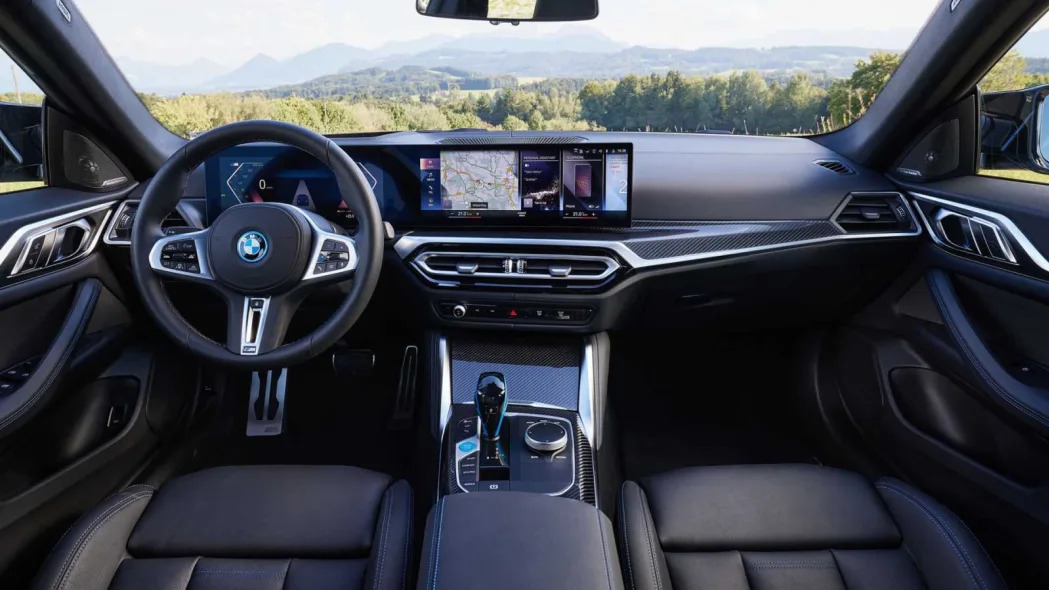
Like a Lightning, Rivian or Lucid Air, the 536-horsepower i4 M50 rewires your brain for expectations of performance. Picture a 382-horsepower M440i Gran Coupe — already a potent sports sedan — only insanely faster, quieter and smoother. Picture the pace of a 503-hp M3 or M4 Competition (and faster for passing), but less flinty and hyperactive, for thousands of dollars less. All that comes in a familiar, fluid 4 Series GC shape, with a rich interior, just-right seats, new iDrive 8.0 infotainment (with dramatic Curved Screen displays and massive head-up display), and versatile hidden-hatchback layout. It’s so good that even the grille’s bloated kidneys — like a codpiece for some cheesy German metal band — elicit a “whaddaya gonna do?” shrug. The closed, plastic-shielded grille integrates a 10-position air flap to reduce drag.
Unlike a nearly identically sized Tesla Model 3, there’s no frunk. Popping the i4 M50’s hood (and plastic bay cover) reveals not a classic BMW inline six, but a power inverter, strut bracing, a gaggle of hoses and, as this is the dual-motor M50, an electric drive unit. In the rear-drive eDrive40, the latter is missing, resulting in a conspicuous void. There’s lidded access to a 12-volt battery, and fillers for coolant, brake and windshield fluid.
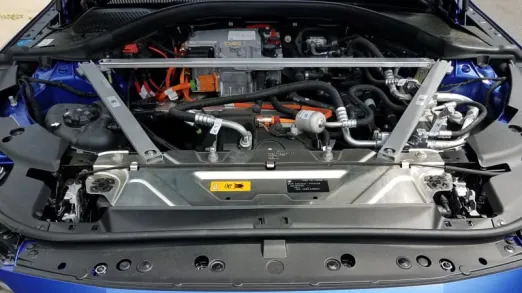
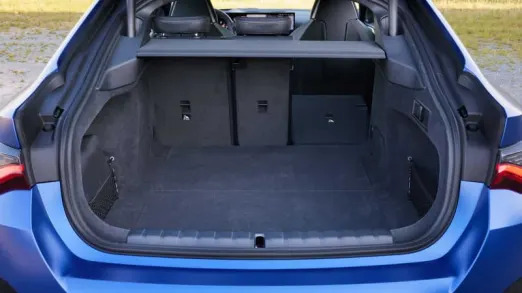
Thanks to that ICE-based platform, the i4’s vestigial transmission tunnel does steal some back-seat space. It also gives up cargo space behind rear seats, with 10 cubic feet versus 16.6 for the 4 Series GC (Autoblog testing indicated it’s more useful than that 10 cubes implies, but is definitely compromised). At least the GC starts out as the roomiest of all the mongrel sedan/coupe/hatchbacks. Folding the i4’s seats opens a massive 45.6-cubic-foot hatch. That’s nearly identical to the standard GC, appreciably more than an Audi S5 Sportback, Kia Stinger or most notably, the Polestar 2.
As the first electric Bimmer touched by the M Division, the i4 M50 gets a pliant adaptive suspension that benefits greatly from an EV’s sharply lower center-of-gravity. The latest CLAR platform makes room for an 83.9 kilowatt-hour battery, with 40% more volumetric density than the BMW i3. There’s 81.5 kWh of net usable power, an unusually high 97% of the total.
During my drive in New York and environs, the i4 M50 took its unfair fight to the populace with 536 hp and 586 pound-feet of torque. Or, as I prefer, 143 more pound-feet than a Lamborghini Huracan Evo Performante. That’s a 154-hp jump over an M440i GC, and 33 more horses and 107 extra pound-feet versus an M4 Competition. Officially, BMW says the i4 M50 takes 3.7 seconds to reach 60 mph. But the i4 M50 will actually scorch 60 mph in 3.3 seconds, about 0.2-seconds faster than an M4 Competition. That’s best accomplished with a launch control start. Unsurprisingly, the body squirms a bit under the stress, requiring attention to keep the car pointed straight. It’s worth the effort.
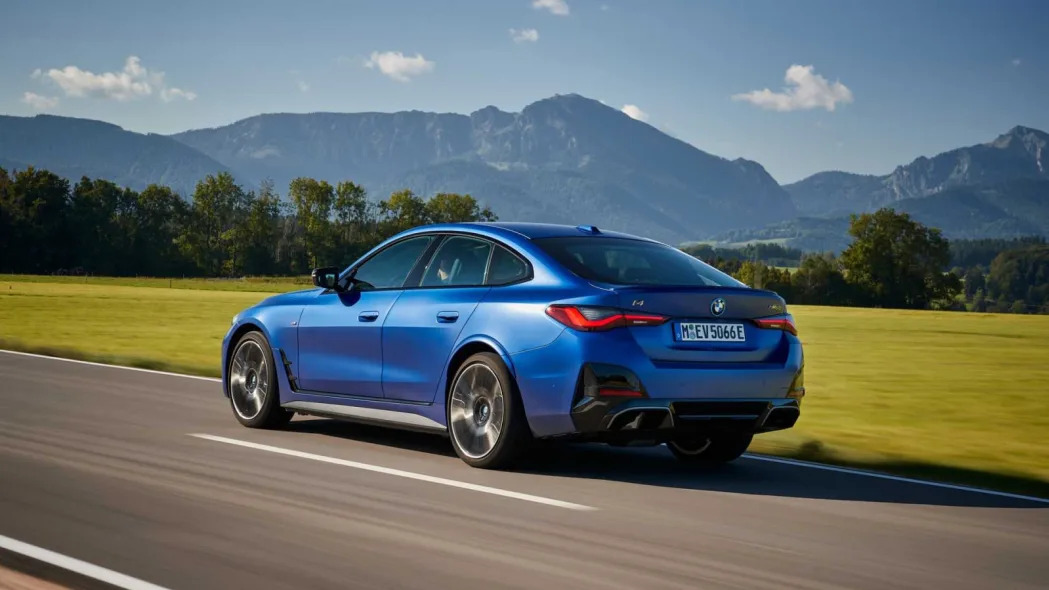
Like the iX, the i4 can set a pace that defies speed limits and reason — with better handling, luxury and sophistication than a Model 3. It’s not tuned to M-levels of agility, but that’s no surprise in this more civilian-focused machine. Push hard, and you’ll feel some of the i4 M50’s 700-pound weight gain versus an M440i GC. Yet the i4 grips so well, especially on optional 20-inch summer Pirelli P Zeros, that it’s easy to use throttle to tweak the driving line, get back on power super-early, and let the AWD dig your way out.
My ears judge the BMW’s “Iconic” powertrain sound, designed by movie composer Hans Zimmer, as the best of current EVs; in part because they actually sound like bassy BMW engine notes, with a roboticized sci-fi flourish.
This being BMW, there are too many options for performance settings. But it pays off with regenerative brakes (“recuperative” to BMW) that underscore the performance expertise of BMW and M. Stopping power is spectacular, with beautifully consistent pedal feel. The console lever’s “B” setting allows one-pedal driving, with automatic rolling starts when you lift off the brake at stoplights. Beyond that, the iDrive screen offers regen levels in High, Medium and Low. Moderation being good, Medium is like the Apollonian ideal of electric regen, nailing the feel of smooth engine braking in a stick-shift car. Beyond that, an ingenious Adaptive setting scans traffic and road conditions, including on curves, to automatically adjust regen on-the-fly. Ease off throttle on the open highway, and the i4 coasts almost like a gasoline BMW. Storm ahead to catch up to traffic — which happens quickly and often — and the BMW decelerates more robustly to smoothly match the leaders’ pace. It’s like a smarter, more driver-engaged version of adaptive cruise control.
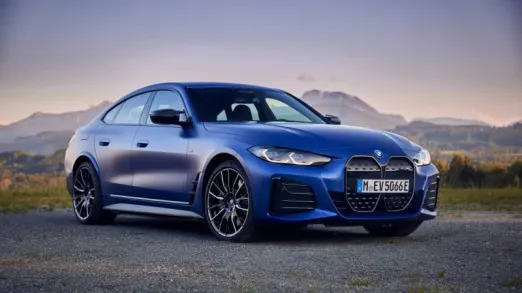

BMW i4 M50 left, BMW i4 eDrive40 right
The i4 M50 can also top the EPA’s 227-mile range estimate, for the model with 20-inch wheels, which is a big drop from 270 miles on standard 19’s. (The EPA credits the single-motor eDrive 40 model with up to 301 miles). Still, everyday driving had my Bimmer on pace for at least 260 miles, which means a 19-inch-wheel model should deliver roughly 300 real-world miles. Anything around 270 miles is on direct par with a Tesla Model 3 Performance, whose real-world stamina rarely matches EPA estimates. (A Model 3 Long Range can knock out 340 miles, but can’t touch the i4 M50’s performance). Gratuitous romping dropped range closer to 230 miles, but look at it this way: That’s several hours worth of spanking every overmatched ICE car, every time you charge.
There’s no compromise in charging ability, with the i4 able to sustain peak charging above 200 kilowatts, given the proper DC charger. After a drive to Long Island left me with 19 miles of remaining range, I hooked into a 150-kilowatt Electric America charger at a shopping mall. The i4 slurped up juice at roughly 157 kilowatts, more than the stated charger maximum. In 32 minutes, I filled the battery from 6% to 80%, and kept charging for 10 more minutes to reach 91% as the rate slowed to protect the prismatic battery cells aboard.
My i4 M50i was brimming with BMW options, including $2,800 worth of M carbon fiber on the body; the compelling Curved Display ($1,000); assistance packages for Parking and semi-autonomous hands-free driving ($2,400 combined), and a High Performance package with 20-inch M wheels for $2,500. That lifted a $66,895 base price to $82,820. A rear-drive i4 eDrive40 starts from $56,395, or a reasonable $48,895 after a $7,500 federal tax credit. Post-credit, the i4 M50’s base fare falls to $59,395, or $75,320 for my test model. An M4 Competition with 33 fewer horses starts from nearly $76,000. The last one I drove rang up $99,545 with options. That’s $24,000 more than this near-loaded i4 M50. On top of any savings, the i4 offers its electric advantages at a fraction of the cost of gasoline, zero tailpipe emissions, and less pricey maintenance from lab-coated BMW techs. Maybe you still want, and can afford, an M4 as a dedicated performance tool, including for track days. But the i4 versus any 4 Series Gran Coupe? Game over, my friend.
Related video:
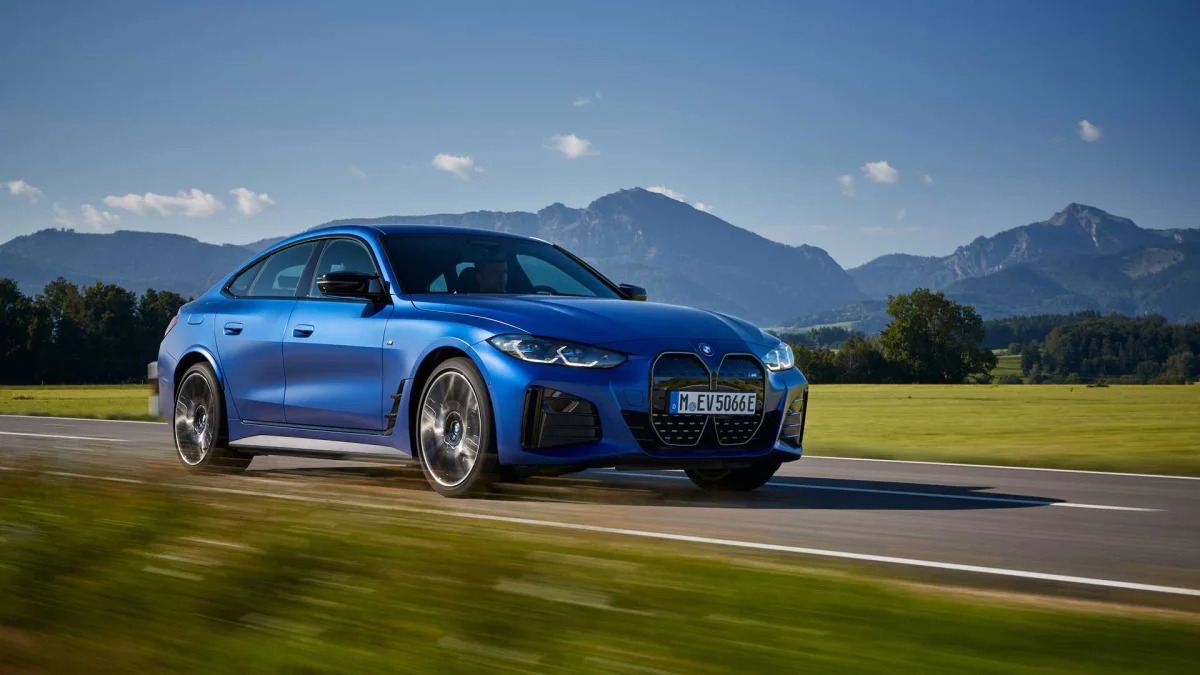










Sign in to post
Please sign in to leave a comment.
Continue